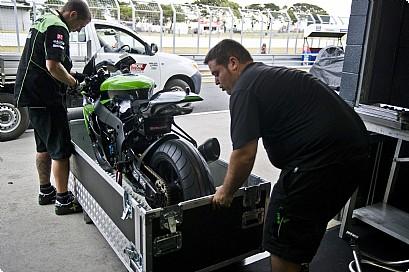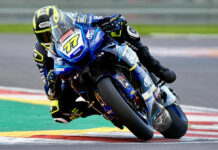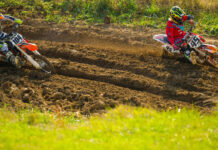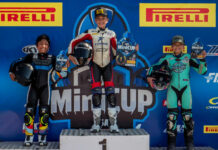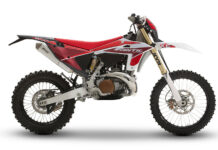As you read this the European arm of the Kawasaki Racing Team is eagerly anticipating the imminent return of all their bikes, spares and equipment after a successful opening round in Australia. The anticipation is understandable, as all their most important kit has been away from their base of operations near Barcelona for over a month now. The return of the official Kawasaki SBK material marks the ‘real’ end of the first flyway round for the team itself. One round, yet one month and lots of resources in the making. This is the first year in which the former Kawasaki WSS team has taken on responsibility for operating Kawasaki’s official FIM Superbike World Championship project on the ground. And in the case of the Australian round, sometimes operating while things are in mid-air too. It is almost impossible to overestimate the logistical planning and power that has to be unleashed to take a modern-day SBK team from Europe (as well as many development parts and engines from Japan) to the south of Australia so early in the new race season. The simple fact is that planning for this first round started just as soon as last season was completed. Also, did we mention that because there were three days of ‘free’ testing (13-15 February) at Phillip Island before the official IMS tests (20-21 February) and then a three-day race meeting (24-26 February), everything had to be in Australia a week earlier than most previous years? And more of it than usual, simply to be able to handle eight full days of track action in such a short period? It was certainly a challenge for new KRT race team manager Guim Roda and his crew, who until 2011 looked after the Provec Motocard.com official Kawasaki WSS team. “This year all is new for us and maybe we are still learning after we did Supersport for so long, because we have tried to keep the kilos we brought as low as possible. But we still flew 4,100kg just over four tonnes – from Europe. Each complete bike weights just over 160kg, so you can see that there was a lot of other material to transport.” As it turns out, it was a challenge they met and matched up to well. Roda acknowledges that the series organisers, IMS, provide a good service to help the regular teams with long haul transport costs, even this year when the free tests took place well before the official IMS ones. “We have an allowance from IMS, and they acknowledge that we had some kilos of freight allowance from Supersport last year and they transferred that to Superbike for this year, which is really appreciated.” It is, in fact, a door-to-door service that IMS provide, on the way out and on the way back. “All the material was collected from us in Barcelona, at our workshops. A truck takes it to Italy and they fly it to Australia from Milan. The material arrives directly at the pit box in Australia. We had all the material ready to be collected from Barcelona on 4th February. Normally it takes eight or nine days from then to arrive at the track itself. From Australia back to Spain it will arrive on maybe 6 or 7 March. It is a good service.” It was not only Europe that Kawasaki sent material from for the opening tests and round one, as Roda explained in Australia. “The Japanese have sent chassis and some other material from the home factory directly to Australia, so we will take some of that back with us to Europe. We only brought around seven main flight cases with us and we brought four engines in their own boxes here. Six engines came direct to Australia from Japan. The way to bring things from country-to-country is not easy because you have to make special paperwork to transport all the things and then send them back again. It is complicated!” So much for the cargo, the parts, the metal and plastics. What about their people? With all the testing, there were also more KHI engineers and staff in Australia than would be normal in other circumstances. Roda explains the Aussie numbers game as far as staff members are concerned. “There were five people from KHI at the tests, and the total became seven for the races. From Europe we brought 21 people. We are not the biggest team in the paddock and, in fact, I think we are one of the more compact teams. But last year in Supersport we were eleven people.” Easily the biggest complication for Roda, and the two team co-ordinators brought to Australia rather than just one, was the private tests. In the IMS tests single make tyre supplier Pirelli provided all the rubber. But, for the preceding free tests, it was a case of bring your own. “We used standard tyres and from the point of view of using Pirellis the way they make their tyres means that they can make many tyres at the same time, so the cost for racing tyres is the same as you can buy them in the shop,” said Roda. “Of course they can have sometimes seven to eleven compounds to choose from. We chose the three or four we thought would work in Australia for the tests, bought them in Europe and brought them with us because they do not have these compounds in Australia. We hired a company in Australia to fit tyres for us at the tests, for a few Euros per tyre.” Race fuel was another main consideration and given that it is by nature a flammable material, importation across borders can be a particularly complicated business. Enter team sponsor Elf, and some special assistance to the team which was clearly a great help. “Our fuel came from our sponsor Elf and they took care about the shipment, which was very much appreciated. It is dangerous material and it can be difficult to manage these things with customs etc. This was a really big help for the test and the race.” All this joint effort paid off in some style for the official Kawasaki Racing Team at Phillip Island, with Tom Sykes scoring fourth and third places after taking pole position in combined qualifying. It may have taken a significant joint effort to get everybody and everything to and from Australia for round one, but it certainly proved worthwhile as Sykes left Australia overall third in the points.
Kawasaki Outlines The Challenges Of Moving A Superbike Team From Spain To Australia
Kawasaki Outlines The Challenges Of Moving A Superbike Team From Spain To Australia
© 2012, Roadracing World Publishing, Inc.
